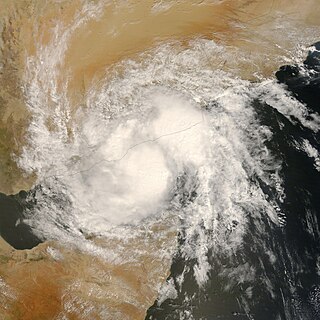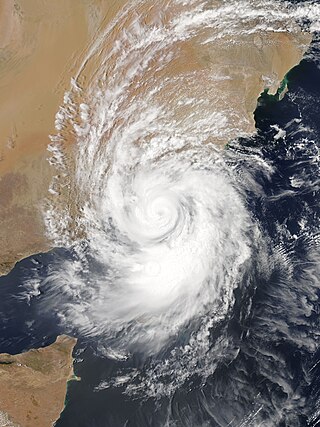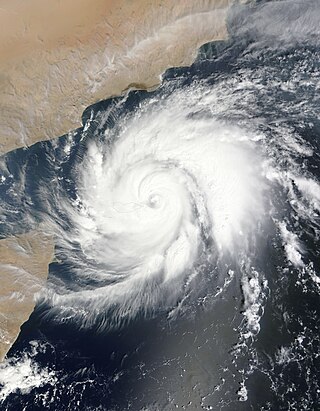
Hurricane Gordon was an erratic, long-lived, and catastrophic late-season hurricane of the 1994 Atlantic hurricane season. The twelfth and final tropical cyclone of the season, Gordon formed as a tropical depression in the southwestern Caribbean on November 8. Without strengthening, the depression made landfall on Nicaragua. Later on November 10, the system began to strengthen as it tracked further from land, and it quickly strengthened into Tropical Storm Gordon, the seventh named storm that season. Gordon also made landfalls in Jamaica and Cuba while a minimal tropical storm. It entered the southwestern Atlantic while resembling a subtropical cyclone. By the time it entered the Gulf of Mexico, the storm was fully tropical again. Tropical Storm Gordon later crossed the Florida Keys, and turning to the northeast it made landfall in Fort Myers, Florida. Gordon strengthened after it re-entered the Atlantic Ocean, becoming a hurricane on November 17. It briefly threatened North Carolina while turning to the northwest, although it turned to the south and weakened. Gordon deteriorated into a tropical depression and struck Florida again at that intensity on November 20. It turned to the north and dissipated the next day over South Carolina.

Intense Tropical Cyclone Leon–Eline was the second longest-lived cyclone in the Indian Ocean, behind Cyclone Freddy, traveling over 11,000 km (6,800 mi) during its 29-day track through the Indian Ocean, throughout the month of February. The cyclone formed on 1 February 2000, in the Australian basin as Tropical Cyclone Leon, and was renamed Eline after crossing 90° E into the South-West Indian Ocean; there, the Météo-France office in Réunion (MFR) tracked the storm's movement and intensity. Late on 17 February, Eline made landfall near Mahanoro, Madagascar, with 10‑minute winds of 165 km/h (103 mph). The storm rapidly weakened over land, but restrengthened in the Mozambique Channel to reach peak 10‑minute winds of 185 km/h (115 mph), making it an intense tropical cyclone. On 22 February, Eline made landfall about 80 km (50 mi) south of Beira, Mozambique, near peak intensity. Eline quickly weakened over land as it moved across Southern Africa, finally dissipating over eastern Namibia on 29 February.

Hurricane Lili was a relatively long-lived hurricane of the 1996 Atlantic hurricane season that affected countries from Central America to the United Kingdom. Lili formed on October 14 from a tropical wave, which emerged from the coast of west Africa on October 4. After the storm formed, further strengthening of Lili was gradual, first to tropical storm status on October 16 and then to hurricane status on October 17. The next day, Lili struck Cuba and moved across the central portion of the island, the first hurricane to hit the country since Hurricane Kate in 1985. After emerging into the Atlantic Ocean, the hurricane accelerated northeastward, briefly peaking as a category 3 hurricane on the Saffir-Simpson Hurricane Scale near the Bahamas. For almost an entire week, Hurricane Lili oscillated in intensity while fluctuating several times in forward speed. About two weeks passed before Lili transitioned into an extratropical storm north of the Azores on October 27, which subsequently moved across Ireland and Great Britain.

The 2008 North Indian cyclone season was one of the most disastrous tropical cyclone seasons in modern history, causing more than 140,000 fatalities and over US$15 billion in damage. At the time, it was the costliest season in the North Indian Ocean, until it was surpassed by 2020. The season has no official bounds but cyclones tend to form between April and December. These dates conventionally delimit the period of each year when most tropical cyclones form in the northern Indian Ocean. There are two main seas in the North Indian Ocean—the Bay of Bengal, which is east of India, and the Arabian Sea, which is west of India. The official Regional Specialized Meteorological Centre in this basin is the India Meteorological Department (IMD), however the Joint Typhoon Warning Center releases unofficial advisories for military interests. An average of four to six storms form in the North Indian Ocean every season. Cyclones occurring between the meridians 45°E and 100°E are included in the season by the IMD.

The 1996 North Indian Ocean cyclone season featured several deadly tropical cyclones, with over 2,000 people killed during the year. The India Meteorological Department (IMD) – the Regional Specialized Meteorological Center for the northern Indian Ocean as recognized by the World Meteorological Organization – issued warnings for nine tropical cyclones in the region. Storms were also tracked on an unofficial basis by the American-based Joint Typhoon Warning Center, which observed one additional storm. The basin is split between the Bay of Bengal off the east coast of India and the Arabian Sea off the west coast. During the year, the activity was affected by the monsoon season, with most storms forming in June or after October.

The 1994 North Indian Ocean cyclone season was a below-average year in which eight tropical cyclones affected seven countries bordering the North Indian Ocean. The India Meteorological Department tracks all tropical cyclones in the basin, north of the equator. The first system developed on March 21 in the Bay of Bengal, the first March storm in the basin since 1938. The second storm was the most powerful cyclone of the season, attaining maximum sustained winds of 215 km/h (135 mph) in the northern Bay of Bengal. Making landfall near the border of Bangladesh and Myanmar, the cyclone killed 350 people and left US$125 million in damage.

Deep Depression ARB 02 was a weak yet costly tropical cyclone which caused extensive damage and loss of life in Yemen. The sixth tropical cyclone and third deep depression of the 2008 North Indian Ocean cyclone season, ARB 02 formed in the Arabian Sea on October 19 from the same broader system which would spawn Moderate Tropical Storm Asma in the southern Indian Ocean around that time. Moving generally westward, the depression failed to intensify further, reaching maximum sustained winds of 55 km/h (35 mph). It would weaken, becoming a remnant low on October 23. Later that day, the system's remnants would make landfall near Ash Shihr in eastern Yemen.

Very Severe Cyclonic Storm Phet was a powerful tropical cyclone that made landfall on Oman, Western India, and Pakistan. The third named cyclone of the 2010 cyclone season, Phet developed in the Arabian Sea on May 31 to the west of India. With conducive environmental conditions, the storm intensified to reach peak sustained winds of 155 km/h (95 mph) on June 2, based on analysis by the India Meteorological Department (IMD). On the next day, Phet dropped heavy rainfall while moving across eastern Oman, with a peak of 603 mm (23.7 in) in Qurayyat. The rains flooded arid areas and collected into wadis – normally dry river beds. Thousands of homes were wrecked across Oman. There were 24 fatalities in the country, and damage was estimated at US$780 million.

Cyclonic Storm Keila was the first named storm of the 2011 North Indian Ocean cyclone season. A weak system for much of its duration, Keila developed in the western Arabian Sea in late October 2011, amid an area of marginally favorable conditions. On November 2, it briefly organized enough to be classified as a cyclonic storm, which has maximum sustained winds of at least 65 km/h (40 mph). Given the name Keila by the India Meteorological Department (IMD), the storm quickly moved ashore southern Oman near Salalah, and weakened while meandering over the country. The remnants soon after moved offshore, dissipating on November 4.

Tropical Cyclone Kesiny was the first recorded tropical cyclone – the equivalent of a minimal hurricane – to make landfall in the month of May in the south-west Indian Ocean. The final named storm of the busy 2001–02 South-West Indian Ocean cyclone season, Kesiny formed on May 2 from a trough near the equator. Its formation was the result of an increase in the Madden–Julian oscillation, which also contributed to a twin storm in the north Indian Ocean that hit Oman, and another set of storms in northeast and southeast Indian Ocean. Kesiny initially moved to the southeast, but later turned to the southwest due to a strengthening ridge. On May 6, it intensified into a tropical cyclone, but later weakened and was not expected to re-strengthen. However, Kesiny developed an eye and re-intensified into a tropical cyclone on May 9, reaching peak winds of 130 km/h (81 mph) before striking Madagascar about 60 km (37 mi) southeast of Antsiranana. It weakened while crossing the country, and after turning to the south it struck the country again before dissipating on May 11.

Extremely Severe Cyclonic Storm Chapala was a powerful tropical cyclone that caused moderate damage in Somalia and Yemen during November 2015. Chapala was the third named storm of the 2015 North Indian Ocean cyclone season. It developed as a depression on 28 October off western India, and strengthened a day later into a cyclonic storm. Chapala then rapidly intensified amid favorable conditions. On 30 October, the India Meteorological Department (IMD) estimated that Chapala attained peak three-minute sustained winds of 215 km/h (135 mph). The American-based Joint Typhoon Warning Center (JTWC) estimated sustained winds of 240 km/h (150 mph), making Chapala among the strongest cyclones on record in the Arabian Sea. After peak intensity, Chapala skirted the Yemeni island of Socotra on 1 November, becoming the first hurricane-force storm there since 1922. High winds and heavy rainfall resulted in an island-wide power outage, and severe damage was compounded by Cyclone Megh, which struck Yemen a week later. Chapala means 'scrutiny' in Bengali.

The October 1996 India cyclone had an unusual and protracted path that spanned much of the northern Indian Ocean. It originated in a weather disturbance that formed on October 14 in the southern Bay of Bengal, off India's east coast. Moving westward, it struck Andhra Pradesh on October 17 as a well-defined low-pressure area. It crossed southern India and reorganized in the Arabian Sea off the western coast of India. The system developed into a depression on October 22 and quickly intensified while moving northward. By October 24, the cyclone approached hurricane intensity as it developed an eye, reaching peak winds of at least 110 km/h (70 mph). On October 25, the storm abruptly stalled and weakened off Gujarat, and progressed southwestward as a minimal storm. It was no longer classifiable as a tropical cyclone by October 28, although its remnants persisted until November 2 when they dissipated east of Somalia.

Extremely Severe Cyclonic Storm Megh is regarded as the worst tropical cyclone to ever strike the Yemeni island of Socotra, causing additional destruction there after Cyclone Chapala hit the same island. Megh formed on November 5, 2015, in the eastern Arabian Sea, and followed a path similar to Chapala. After moving northward, the cyclone turned to the west, and fueled by warm water temperatures, it quickly intensified. On November 7, the storm developed an eye in the center and began to rapidly intensify into a mature cyclone. By the next day, the India Meteorological Department estimated peak 3 minute sustained winds of 175 km/h (110 mph), and the American-based Joint Typhoon Warning Center estimated 1 minute winds of 205 km/h (125 mph). Shortly thereafter, the cyclone brushed the northern coast of Socotra. The storm steadily weakened thereafter, especially after it skirted the northern Somalia coast. After entering the Gulf of Aden, Megh turned to the west-northwest and struck southwestern Yemen on 10 November as a deep depression, dissipating shortly thereafter.

The 2018 North Indian Ocean cyclone season was one of the most active North Indian Ocean cyclone seasons since 1992, with the formation of fourteen depressions and seven cyclones. The North Indian Ocean cyclone season has no official bounds, but cyclones tend to form between April and December, with the two peaks in May and November. These dates conventionally delimit the period of each year when most tropical cyclones form in the northern Indian Ocean.

Cyclonic Storm Sagar was the strongest tropical cyclone to make landfall in Somalia and Somaliland in recorded history until Gati in 2020, and the first named cyclone of the 2018 North Indian Ocean cyclone season. Forming on May 16 east of the Guardafui Channel, Sagar intensified into a cyclonic storm on the next day, as it gradually organized. The storm turned to the west-southwest and traversed the entirety of the Gulf of Aden, making landfall over Somaliland on May 19, farther west than any other storm on record in the North Indian Ocean. Sagar weakened into a remnant low on May 20.

Extremely Severe Cyclonic Storm Mekunu was the strongest storm to strike Oman's Dhofar Governorate since 1959. The second named storm of the 2018 North Indian Ocean cyclone season, Mekunu developed out of a low-pressure area on May 21. It gradually intensified, passing east of Socotra on May 23 as a very intense tropical cyclone. On May 25, Mekunu reached its peak intensity. The India Meteorological Department estimated 10 minute sustained winds of 175 km/h (110 mph), making Mekunu an extremely severe cyclonic storm. The American-based Joint Typhoon Warning Center estimated slightly higher 1 minute winds of 185 km/h (115 mph). While at peak intensity, Mekunu made landfall near Raysut, Oman, on May 25. The storm rapidly weakened over land, dissipating on May 27.

Very Severe Cyclonic Storm Luban was the third tropical cyclone to affect the Arabian Peninsula during the 2018 North Indian Ocean cyclone season, after cyclones Sagar and Mekunu in May. Luban developed on October 6 in the central Arabian Sea, and for much of its duration, maintained a general west-northwestward trajectory. On October 10, the India Meteorological Department (IMD) upgraded Luban to a very severe cyclonic storm – equivalent to a Category 1 hurricane – and estimated maximum sustained winds of 140 km/h (85 mph). The storm made landfall on October 14 in eastern Yemen, as a cyclonic storm. The storm quickly weakened over the dry, mountainous terrain of the Arabian Peninsula, before dissipating on October 15.

Extremely Severe Cyclonic Storm Tej was a strong tropical cyclone that formed over the central-south Arabian Sea and made landfall on Yemen. It was the first cyclone to make landfall in the nation since Cyclone Luban of 2018. The sixth depression and the third named cyclonic storm of the season, Tej coexisted with Cyclone Hamoon in the Bay of Bengal, a rare phenomenon not seen since 2018. The cyclone then took a northwestward track in the Arabian Sea and made landfall in Al Mahrah Governorate of Yemen between 23 and 24 October 2023, bringing significant rainfall and flooding across the eastern half of the country and western parts of Oman.




















